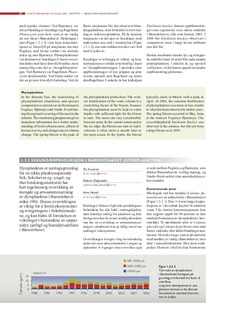| dc.description.abstract | The average zooplankton biomass measured
in August–September 2006 (8.6 g dry weight/m2) was above the long-term
mean (7.14 g dry weight/m2), and has
slightly increased since 2001 (5.85 g dry
weight/m2). Atlantic water masses contain
the highest biomass, stressing the importance
of advective transport of zooplankton
from the Norwegian Sea, and the favourable
higher temperatures in these waters
that significantly influences the central and
western part of the Barents Sea. The adult
capelin stock was still very low in 2006.
Other plankton consumers like juvenile
cod, capelin, haddock, redfish are important,
but particularly young herring, which
has been very abundant the last few years,
surely influence zooplankton biomass.
Additional species such as blue whiting
and sandeel, now seem to extend their distribution range in the Barents Sea, hence
their predation pressure on zooplankton
can be expected to increase. The average
zooplankton abundance in 2006 suggests
that the conditions for local production is
favourable for 2007, and slightly improved
with respect to 2006. | en |
